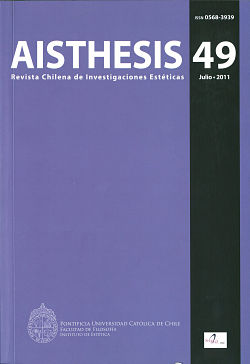Jorge Luis Borges’s «The Immortal»: the Self, Infinites, Absolutes, and Final Vocabularies
Main Article Content
Abstract
Jorge Luis Borges often consulted Mathematics and Imagination by E. Kasner and J. Newman, where they address the set theory (branch of mathematics that studies the relationship between sets) proposed by Georg Cantor (18451918), and in which transfi nite arithmetic (beyond fi nite arithmetic) is established, and an epistemic system created to represent different levels of the infi nite. Thus, Cantor labels the different levels of the infi nite by assigning to each the fi rst let
AISTHESIS Nº 49 (2011): 175-191176 ter of the Hebrew alphabet, the Aleph, followed by a number, depending on the level of infi nite he is referring to (Aleph-zero, Aleph-one, etc.). Following these ideas, Borges weaves several narratives, discussing the infi nite and the absolute. An example of such narratives is the collection of stories compiled under the title The Aleph, which opens with «The Immortal» and closes with the story that gives the collection its title. The objective of this paper is to study «The Immortal» under the Cantorian lens, so as to discuss one particular absolute, the self, and to suggest that it is impossible to establish a fi nal vocabulary, or a defi nite defi nition, about this topic. This impossibility, Borges proposes, is in part due to the apparent fi nitude of language, on the one hand, and on the other, the fallible attributes of human memory are also crucial when it comes to defi ning anything. However, being the ironist Borges is, he is capable of providing through «The Immortal» a re-description of these issues by means of a transfi nite language that resolves some paradoxes while at the same time reveals others. Due to this way of writing, I propose Borges fosters a continuation of the dialogue among different disciplines. Though I will center my analysis on «The Immortal», to develop these ideas I will also revisit other stories in The Aleph departing from a theoretical approach rooted in the philosophy of language.
Downloads
Article Details

This work is licensed under a Creative Commons Attribution-NonCommercial-ShareAlike 4.0 International License.
All contents of this electronic edition are distributed under the Creative Commons license of "Attribución-shareAlike 4.0 Internacional" (CC-BY-SA). Any total or partial reproduction of the material must mention its origin.
The rights of academic works published in this publication belong to their authors., who grant to AISTHESIS: Revista Chilena de Investigaciones Estéticas the license for its use. The management of the permits and the authorization of the publication of the images (or of any material) that contains copyright and its consequent rights of reproduction in this publication is the sole responsibility of the authors of the articles
